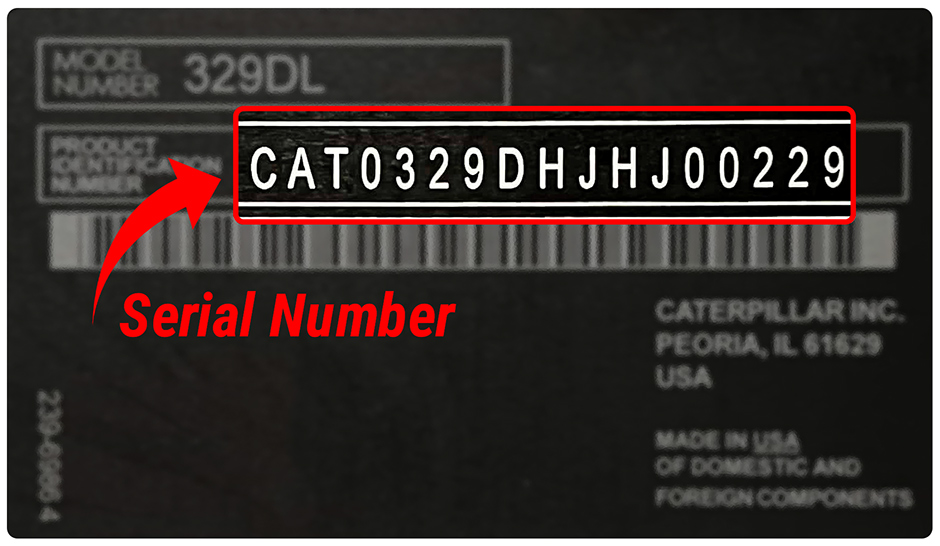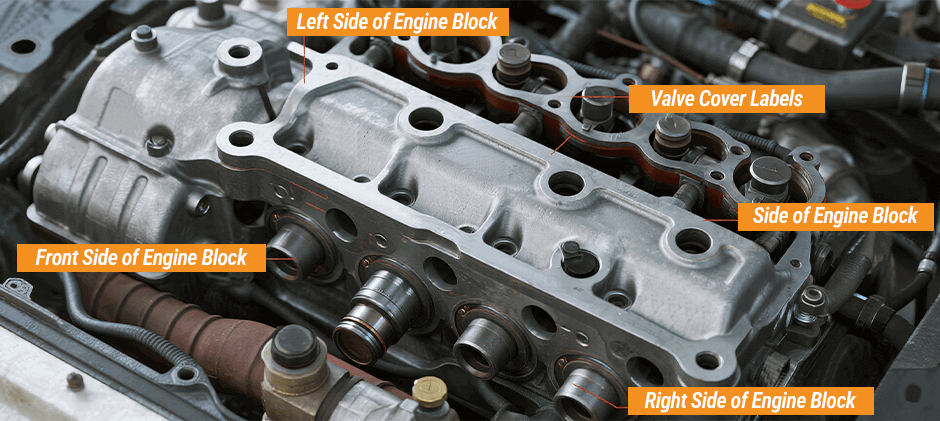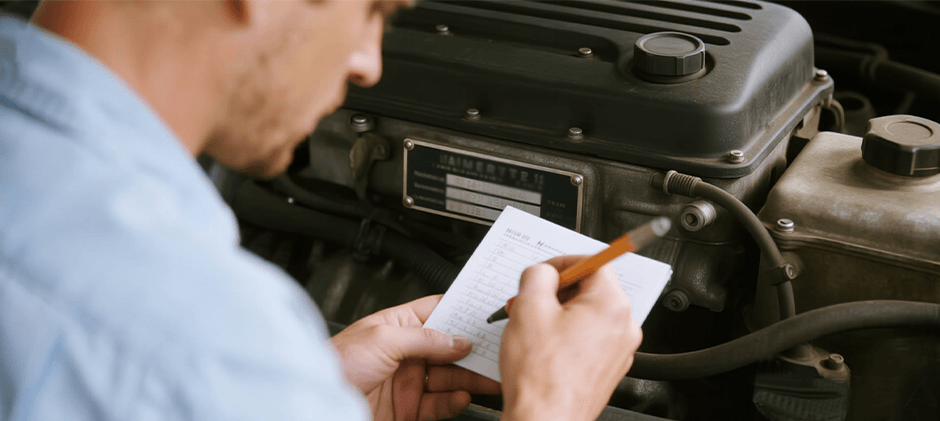Ever been on the phone trying to order parts, and the person asks for your engine serial number? You’re standing there, grease up to your elbows, searching every visible surface of your engine like you’re on a treasure hunt. At FridayParts, we’ve guided thousands of customers through this exact scenario over our 16 years in business. Engine serial numbers aren’t just random digits – they’re the DNA of your diesel engine, telling its complete story from birth to present day. Let’s decode the mystery and show you exactly where to find these crucial numbers and what they mean.
Why Engine Serial Numbers Matter
Your engine serial number is like your engine’s social security number – it’s unique, permanent, and tells you everything you need to know about that specific engine. This isn’t just bureaucratic nonsense; it’s critical information that can save you time, money, and headaches.

What Your Serial Number Reveals:
- Exact engine model and configuration
- Manufacturing date and location
- Original power rating and specifications
- Emissions certification level
- Which parts fit your specific engine
- Service bulletin and recall applicability
- Warranty status and coverage
Without the correct serial number, you’re essentially guessing at parts compatibility. “I can’t tell you how many times someone’s ordered parts for a ‘C15 CAT engine,’ only to find out they have an early version that uses completely different injectors,” shares one of our parts specialists. “Five minutes finding the serial number saves days of shipping wrong parts back and forth.”
The serial number also protects you from counterfeit parts and ensures you’re getting components designed for your specific engine configuration. Two engines that look identical on the outside might have different internal components based on when and where they were built. Your serial number is the key to getting it right the first time.
Engine Serial Number Formats
Every manufacturer has their system for serial numbers, but once you crack their code, you can learn a lot about your engine before even lifting the hood. Let’s break down how major manufacturers structure their serial numbers.
Caterpillar Serial Numbers:
CAT typically uses a format like: 6NZ12345
- First 3 characters: Engine family prefix (6NZ, MBN, BXS, etc.)
- Remaining digits: Sequential production number
- The prefix tells you the engine series and approximate years
Cummins Serial Numbers:
Cummins uses a longer format: 12345678
- Pure numerical sequence in older engines
- Newer engines may include letters
- ESN (Engine Serial Number) is Cummins’ preferred term
Detroit Diesel Serial Numbers:
Format varies by series: 06R0123456
- First digits often indicate model year
- The letter indicates a manufacturing plant
- The remaining digits are sequential
John Deere/Perkins/Kubota:
These manufacturers each have unique systems:
- Deere often includes the engine type in the serial number
- Perkins uses letter-number combinations
- Kubota typically uses shorter numerical sequences
“Learning to read serial numbers is like learning a new language,” notes a veteran mechanic. “Once you know what to look for, you can tell if someone’s trying to sell you a 2005 engine claiming it’s a 2010, or if that ‘rebuilt’ engine is older than they claim.”

Common Locations for Engine Serial Numbers
Finding your engine serial number shouldn’t require an archaeology degree, but manufacturers don’t always make it easy. Here’s where to look for each major brand, starting with the most common locations.
Caterpillar Engines:
- Primary location: Left side of the engine block, near the front
- Secondary: Valve cover labels
- Also check: Rocker cover gasket area
- C7/C9 engines: Often behind the fuel filter housing
- 3406/C15/C16: Usually eye-level on the left side
Cummins Engines:
- ISX/X15: Front of the engine block, above the fuel pump
- ISB/ISC/ISL: Left side of block, below the exhaust manifold
- Older Big Cam/N14: Top front of the gear housing
- QSB/QSC: Near the injection pump or front gear cover
- Data plate: Often duplicated on the rocker cover
Detroit Diesel Engines:
- Series 60: Left rear corner of the rocker cover
- DD13/DD15/DD16: Option label on valve cover
- Two-stroke engines: Various locations on the block
- MCM label: Contains both engine and MCM serial numbers
International/Navistar:
- MaxxForce engines: Right side valve cover label
- DT466/DT530: Stamped on block above injection pump
- VT365: Similar location to Ford 6.0L Powerstroke
Other Manufacturers:
- Perkins: Usually on the injection pump side of the block
- Deutz: Stamped on block near injection pump
- Kubota: Often on a raised pad on the block
- Yanmar: Typically, on the injection pump mounting surface
“If you can’t find it in the usual spots, look for any machined flat surface on the block,” advises a field service tech. “Manufacturers need a smooth surface for stamping, so check every flat spot. And don’t forget to clean off the dirt – sometimes the number is hiding under years of grime.”
Decoding Your Engine’s Build Information
Once you’ve found your serial number, it’s time to decode what it tells you. This information is crucial for ordering the right parts and understanding your engine‘s capabilities and requirements.
Information Available from Serial Numbers:
- Build date: When your engine rolled off the assembly line
- Manufacturing plant: Where it was built
- Engine arrangement: Specific configuration and options
- Power rating: Original horsepower and torque specs
- Emissions family: EPA certification level
- Parent engine: The Base model is derived from
Using Manufacturer Resources:
Most manufacturers offer online tools or dealer support:
- CAT SIS Web: Caterpillar’s online parts system
- Quickserve Online: Cummins’ free lookup tool
- Detroit Diesel Power Portal: DD’s information system
- Local dealer networks: Often provide free serial number lookups
What to Do with the Information:
Once decoded, document everything:
- Original specifications
- Any special configurations
- Parts supersessions
- Applicable service bulletins
- Warranty cut-off dates
“I keep a folder for each engine with all the serial number information printed out,” shares a fleet manager. “When a truck goes down at 2 AM in another state, having that information ready saves precious time and gets the right parts ordered immediately.”
Red Flags to Watch For:
- The serial number doesn’t match the engine model
- Build date conflicts with vehicle year
- Missing or altered serial numbers
- No records in the manufacturer database
ESN for Parts Ordering
Your Engine Serial Number (ESN) isn’t just helpful for ordering parts – it’s absolutely essential. Here’s why parts suppliers like us always ask for it, and why guessing can cost you big time.
Why ESN Matters for Parts:
- Mid-year changes: Manufacturers update designs without changing model names
- Multiple suppliers: The Same part might have different suppliers by serial number
- Superseded parts: Older parts may be replaced with updated designs
- Configuration specific: Turbo, injectors, and pumps vary by serial number
- Warranty validation: Ensures you get parts covered under existing warranties
Real-World Examples:
Let’s say you need injectors for a CAT C7:
- Early C7 (2003-2004): Uses one injector type
- Mid-production (2005-2006): Updated injector design
- Late production (2007-2009): Another revision
- Without the ESN, you’re gambling on which ones fit
Or consider a Detroit Series 60:
- Pre-1998: Non-EGR configuration
- 1998-2003: Early EGR system
- 2004-2007: Revised EGR with different parts
- The model name stayed the same, but the parts are very different
How We Use Your ESN at FridayParts:
When you provide your serial number, we:
- First, look up your exact engine configuration
- Then, check for any superseded part numbers
- Verify compatibility with your specific build
- Identify any updated parts that improve on the originals
- Finally, ensure you get parts that fit the first time
“I learned the hard way about serial numbers,” admits one owner-operator. “Ordered a water pump for my ‘ISX Cummins’ without checking the serial. Turns out my 2002 engine used a completely different pump than the 2004 version. That mistake cost me three days of downtime.”

Digital Records and Documentation Best Practices
In today’s connected world, keeping track of your engine serial numbers and related documentation shouldn’t rely on grease-stained notebooks (though we still recommend keeping physical backups). Here’s how to organize and protect this vital information.
Creating Digital Records:
- Photograph everything: Serial plates, build sheets, and stamped numbers
- Multiple angles: Sometimes glare or dirt obscures parts of the numbers
- Include context: Show where on the engine the number is located
- High resolution: Zoom in later to read difficult stampings
- Clean before shooting: A rag and some solvent reveal hidden details
Organizing Your Information:
Create a system that works for you:
Equipment Folder Structure:
├── Truck 101 (2018 Peterbilt)
│ ├── Engine Serial: 6NZ12345
│ ├── Photos of serial locations
│ ├── Caterpillar build sheet
│ ├── Parts ordering history
│ └── Service bulletins
├── Truck 102 (2020 Freightliner)
│ ├── Engine Serial: 79123456
│ └── [Similar structure]
Cloud Storage Benefits:
- Access from anywhere
- Share with mechanics or parts suppliers
- Automatic backup
- Version history
- Search capabilities
What to Document:
- Engine serial number and location
- Transmission serial number
- Major component serials (turbo, injection pump, ECM)
- Build sheets and configuration data
- Parts supersession notices
- Warranty information
- Service history tied to the serial number
“My phone has saved me thousands of dollars,” says a small fleet owner. “I keep photos of every serial number, every build sheet, and every parts receipt in cloud folders. When I’m broken down somewhere, I can text the exact information to my parts supplier and know I’m getting the right stuff.”

Troubleshooting Serial Number Issues
Sometimes finding or verifying serial numbers isn’t straightforward. Here’s how to handle common problems that pop up when trying to identify your engine.
Problem: Can’t Find the Serial Number
Solutions:
- Check the operator’s manual for location diagrams
- Look for secondary locations (valve covers, timing covers)
- Contact the previous owner for records
- Check vehicle registration or insurance documents
- Dealer service records often list ESN
Problem: Serial Number is Illegible
Options:
- Try the chalk or crayon rubbing technique
- Use oblique lighting to create shadows
- Clean with specific solvents (brake cleaner works well)
- Take multiple photos with different lighting
- Some dealers can help with partial numbers
Problem: Serial Number Doesn’t Match Records
Possible causes:
- The engine was swapped (common in older equipment)
- Remanufactured engine with a new serial number
- Clerical error in documentation
- Counterfeit or altered engine
Problem: No Records Found for Serial Number
What to do:
- Verify you’re reading it correctly
- Check if the engine is a gray market or imported
- Contact the manufacturer directly
- May be very old pre-digital records
- Consider a professional inspection
When Serial Numbers are Altered or Missing:
Red flags that need investigation:
- Grinding marks where numbers should be
- Mismatched fonts or spacing
- Numbers that don’t follow manufacturer patterns
- Fresh stamping on old engines
- Welded or filled areas on the block
“We once had a customer with a ‘CAT C15’ that no parts fit,” recalls a parts specialist. “Turns out someone had ground off the original serial and restamped it. The engine was a 3406E dressed up to look newer. Always verify suspicious numbers.”
Protecting Your Engine Investment with Proper Documentation
Your engine serial number is more than just digits on metal – it’s the key to maintaining your equipment properly and protecting your investment. Whether you’re running a single piece of equipment or managing a fleet, proper serial number documentation pays dividends.
At FridayParts, we’ve built our business on getting customers the right parts the first time. After 16 years and millions of parts sold, we can tell you that the single biggest factor in ordering success is having the correct engine serial number. It’s why our parts specialists always ask for it, and why FridayParts maintains extensive databases to cross-reference these numbers with the right components.
Key Takeaways:
- Always locate and document your engine serial numbers
- Keep multiple records – physical and digital
- Use the serial number when ordering any parts
- Verify numbers when buying used equipment
- Update records when modifications are made
- Share information with your service providers
Remember, spending 10 minutes finding and recording your engine serial number can save hours of downtime and hundreds of dollars in wrong parts. It’s not just about convenience – it’s about keeping your equipment running efficiently and avoiding costly mistakes.
Fix it once, fix it right – and that starts with knowing exactly what engine you’re fixing. Your serial number is your guide to getting the right parts, following the right procedures, and keeping your diesel running for the long haul.
Need help finding parts for your diesel engine? FridayParts makes it easy. With your engine serial number, our specialists can quickly identify exactly what you need from our inventory of over 70,000 parts. We ship worldwide and pride ourselves on getting you the right part the first time. Visit FridayParts.com or call us – after 16 years in business, we speak fluent serial numbers.
